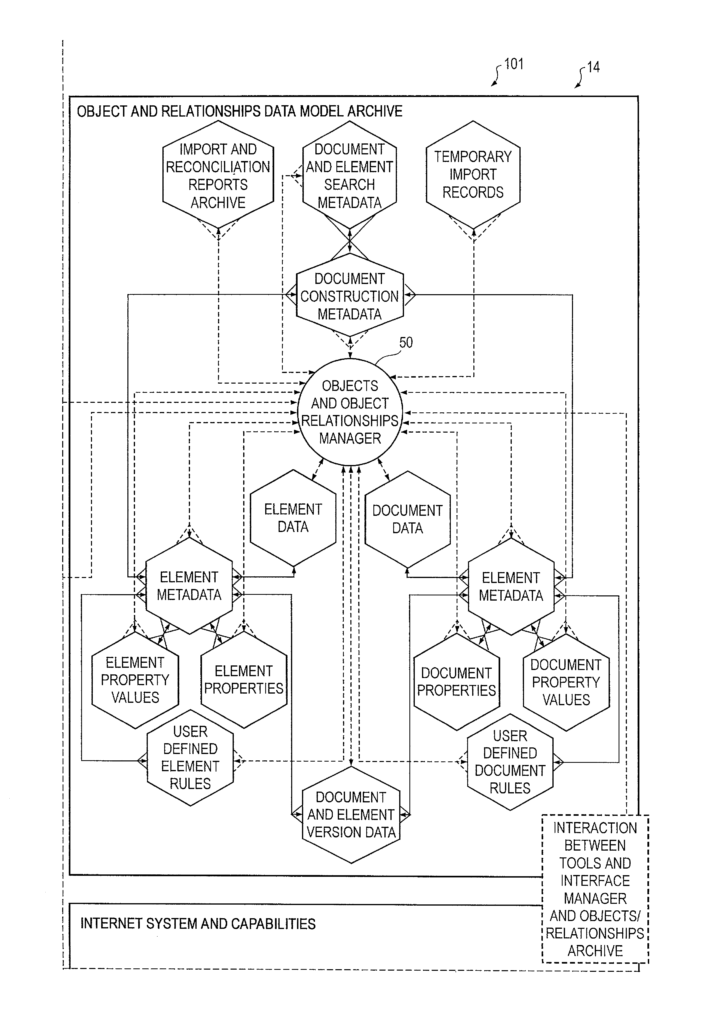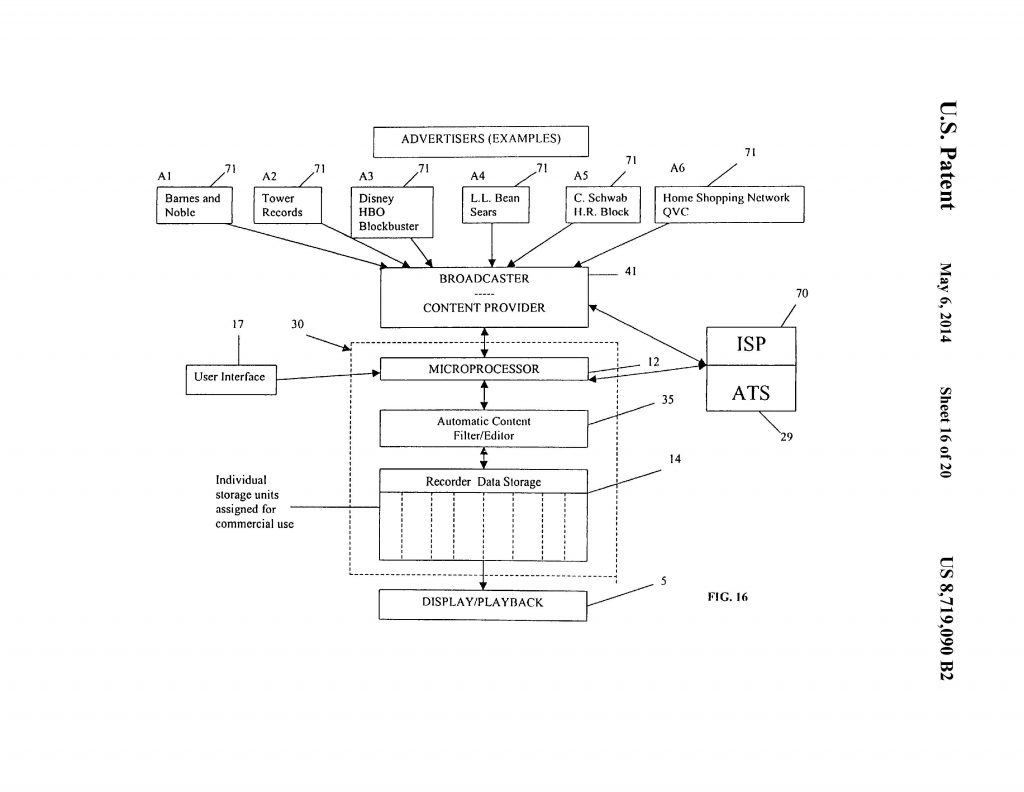 Mr. Berheimer sued HP. HP moved for summary judgment that claims 1–7 and 9 of U.S. Patent No. 7,447,713 are patent ineligible under 35 U.S.C. § 101, and the district court granted the motion.
Mr. Berheimer sued HP. HP moved for summary judgment that claims 1–7 and 9 of U.S. Patent No. 7,447,713 are patent ineligible under 35 U.S.C. § 101, and the district court granted the motion.
The patent relates to digitally processing and archiving files in a digital asset management system. The system parses files into multiple objects and tags the objects to create relationships between them. These objects are analyzed and compared, either manually or automatically, to archived objects to determine whether variations exist based on predetermined standards and rules. This system eliminates redundant storage of common text and graphical elements, which improves system operating efficiency and reduces storage costs. The relationships between the objects within the archive allow a user to “carry out a one-to-many editing process of object-oriented data,” in which a change to one object carries over to all archived documents containing the same object.
Independent claim 1 recites:
1. A method of archiving an item in a computer processing system comprising:
- presenting the item to a parser;
- parsing the item into a plurality of multipart object structures wherein portions of
the structures have searchable information tags associated therewith;
- evaluating the object structures in accordance with object structures previously
stored in an archive;
- presenting an evaluated object structure for manual reconciliation at least where
there is a predetermined variance between the object and at least one of a predetermined standard and a user defined rule.
The Federal Circuit stated that because patent protection does not extend to claims that”monopolize the “building blocks of human ingenuity,” claims directed to laws of nature, natural phenomena, and abstract ideas are not patent eligible. Alice Corp. Pty. Ltd. v. CLS Bank Int’l. The Supreme Court instructs courts to distinguish between claims that claim patent ineligible subject matter and those that “integrate the building blocks into something more.” First, the Federal Circuit is to determine whether the claims at issue are directed to a patent ineligible concept. If so, the Federal Circuit is to consider the elements of each claim both individually and ‘as an ordered combination’ to determine whether the additional elements ‘transform the nature of the claim’ into a patent-eligible application.
The Federal Circuit noted that, at Alice step one, they must “determine whether the claims at issue are directed to a patent-ineligible concept.” The district court held claim 1 is directed to the abstract idea of “using a generic computer to collect, organize, compare, and present data for reconciliation prior to archiving.” Mr. Berkheimer argued that the district court characterized the invention too broadly and simplistically, ignoring the core features of the claims. The Federal Circuit held that claims 1–3 and 9 are directed to the abstract idea of parsing and comparing data; claim 4 is directed to the abstract idea of parsing, comparing, and storing data; and claims 5–7 are directed to the abstract idea of parsing, comparing, storing, and editing data. The Federal Circuit noted that the claims are similar to claims that they held directed to an abstract idea in prior cases In re TLI Commc’ns LLC Patent Litig. and Content Extraction & Transmission LLC v. Wells Fargo Bank, Nat’l Ass’n. In Content Extraction, the claims at issue generally recited a method of 1) extracting data from hard copy documents using an automated digitizing unit such as a scanner, 2) recognizing specific information from the extracted data, and 3) storing that information in a memory. The Federal Circuit held those claims were directed to the abstract idea of 1) collecting data, 2) recognizing certain data within the collected data set, and 3) storing that recognized data in a memory. Similarly, in TLI, the claims recited a “method for recording and administering digital images,” which involved “recording images using a digital pick up unit in a telephone unit,” digitally storing them, transmitting the digital images and classification information to a server, and storing the digital images in the server based on the
classification information. The Federal Circuit held that those claims used only conventional computer components to implement the abstract idea of classifying and storing digital images in an organized manner.
Even though the parser here separates the documents or items into smaller components than the claims determined to be abstract in Content Extraction and TLI, the concept is the same, according to the Federal Circuit. The parsing and comparing of claims 1–3 and 9 are similar to the collecting and recognizing of Content Extraction, and the classifying in an organized manner of TLI. Claim 4 adds the abstract concept of storing, and claims 5–7 add the abstract concept of editing.
That the parser transforms data from source to object code does not demonstrate non-abstractness without evidence that this transformation improves computer functionality in some way. Visual Memory LLC v. NVIDIA Corp. The second step of the Alice test is satisfied when the claim limitations involve more than performance of ‘well understood, routine, and conventional activities previously known to the industry. Content Extraction.
The interesting holding in this case was that the Federal Circuit held that the question of whether a claim element or combination of elements is well-understood, routine and conventional to a skilled artisan in the relevant field is a question of fact. Any fact, such as this one, that is pertinent to the invalidity conclusion must be proven by clear and convincing evidence.
At this stage of the case, there is at least a genuine issue of material fact in light of the specification regarding whether claims 4–7 archive documents in an inventive manner that improves these aspects of the disclosed archival system. Whether claims 4–7 perform well-understood, routine, and conventional activities to a skilled artisan is a genuine issue of material fact making summary judgment inappropriate with respect to these claims.
The Federal Circuit did not decide that claims 4–7 are patent eligible under § 101. They only decided that on this record summary judgment was improper, given the fact questions created by the specification’s disclosure.
 Customedia appealed a decision by the U.S. Patent and Trademark Office holding claims of U.S. Patent No. 8,719,090 and 9,053,494 ineligible under 35 U.S.C. § 101.
Customedia appealed a decision by the U.S. Patent and Trademark Office holding claims of U.S. Patent No. 8,719,090 and 9,053,494 ineligible under 35 U.S.C. § 101. Mr. Berheimer sued HP. HP moved for summary judgment that claims 1–7 and 9 of U.S. Patent No. 7,447,713 are patent ineligible under 35 U.S.C. § 101, and the district court granted the motion.
Mr. Berheimer sued HP. HP moved for summary judgment that claims 1–7 and 9 of U.S. Patent No. 7,447,713 are patent ineligible under 35 U.S.C. § 101, and the district court granted the motion.